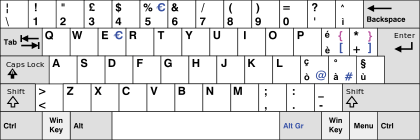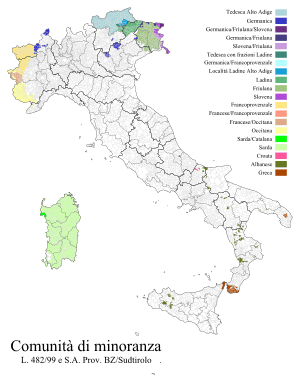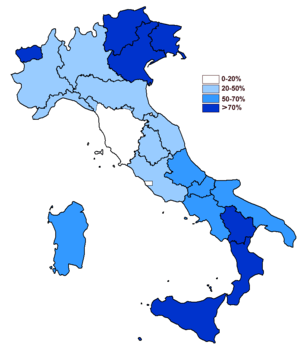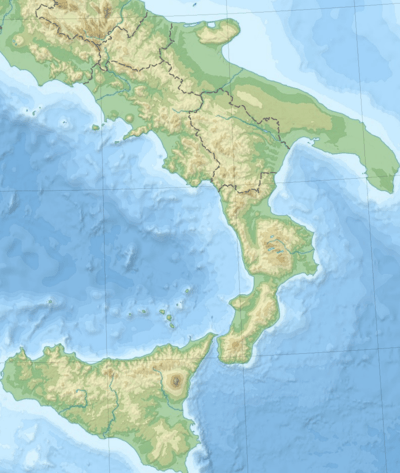Languages of Italy
| Languages of Italy | |
|---|---|
|
| |
| Official languages | Italian |
| Regional languages | see "legal status" |
| Minority languages | see "legal status" |
| Main immigrant languages | Spanish, Albanian, Romanian, Hungarian, and Romani |
| Main foreign languages |
English (34%) French (16%) Spanish (11%) German (5%) Other regional language (6%) |
| Sign languages | Italian Sign Language |
| Common keyboard layouts |
 |
| Source | Special Eurobarometer, Europeans and their Languages, 2006 |

| Part of a series on the |
| Culture of Italy |
|---|
 |
| History |
| People |
| Languages |
| Traditions |
| Cuisine |
| Festivals |
| Religion |
| Art |
| Literature |
|
Music and performing arts |
| Sport |
|
There are a number of regional languages spoken to varying degrees in Italy, most of which belong to various branches of the Romance languages and are hence descendants of Vulgar Latin. The official and most widely spoken language is Italian, a descendant of Tuscan.
All Romance varieties spoken in Italy, except Standard Italian, are often colloquially referred to as "dialects", although for some of them the term may coexist with other labels like "minority languages" or "vernaculars".[6] However, the use of the term "dialect" to refer to the languages of Italy erroneously implies that the languages spoken in Italy are actual "dialects" in the prevailing linguistic sense of "varieties or variations of a language." This is generally not the case in regards to the languages of Italy, as they are, for the most part, not varieties of Standard Italian. Most of the regional languages of Italy evolved or diverged locally from Vulgar Latin alongside, but mostly independently, of what would become Standard Italian, long before the fairly recent spread of Standard Italian throughout Italy. In fact, Standard Italian is itself either a continuation of, or a dialect heavily based on, the Florentine Tuscan language. Most regional languages in Italy are thus better classified as separate languages descended independently from Latin, rather than "dialects" or variations of the Standard Italian language.[7][8] Conversely, with the spread of Standard Italian throughout Italy in the 20th century, regional varieties or actual dialects of Standard Italian, known as regional Italian dialects, have also developed throughout the peninsula.
There are several minority languages that belong to other Indo-European branches, such as Cimbrian (Germanic), Arbëresh (Albanian), the Slavomolisano dialect of Serbo-Croatian (Slavic), and Griko (Hellenic). Other non-indigenous languages are spoken by a substantial percentage of the population due to immigration.[9]
Legal status
Recognition at the European level
Italy is a signatory of the European Charter for Regional or Minority Languages, but is yet to ratify the treaty, and therefore its provisions protecting regional languages do not apply in the country.[10]
The Charter does not, however, establish at what point differences in expression result in a separate language, deeming it an "often controversial issue", and citing the necessity to take into account, other than purely linguistic criteria, also "psychological, sociological and political considerations".[11]
Recognition by the Italian state
Law number 482 of 15 December 1999, recognises the following minority languages as "historical language minorities": Albanian, Catalan, German, Greek, Slovene, Croatian, French, Franco-Provençal, Friulian, Ladin, Occitan, Sardinian (Legge 15 Dicembre 1999, n. 482, Art. 2, comma 1).[12] The law also makes a distinction between those who are considered minority groups (Albanians, Catalans, Germanic peoples indigenous to Italy, Greeks, Slovenes and Croats)[13] and those who are not (all the others).[12]
The original Italian Constitution does not explicitly express that Italian is the official national language. Since the constitution was penned, there have been some laws and articles written on the procedures of criminal cases passed that explicitly state that Italian should be used:
- Statute of the Trentino-South Tyrol, (constitutional law of the northern region of Italy around Trento) – "[...] [la lingua] italiana [...] è la lingua ufficiale dello Stato." (Statuto Speciale per il Trentino-Alto Adige/Südtirol, Art. 99, "[...] [the language] Italian [...] is the official language of the State.")
- Code for civil procedure – "In tutto il processo è prescritto l'uso della lingua italiana. (Codice di procedura civile, Art. 122, "In all procedures, it is required that the Italian language is used.")
- Code for criminal procedure – "Gli atti del procedimento penale sono compiuti in lingua italiana." (Codice di procedura penale, Art. 109 [169-3; 63, 201 att.], "The acts of the criminal proceedings are carried out in the Italian language.")
- Article 1 of law 482/1999 – "La lingua ufficiale della Repubblica è l'italiano." (Legge 482/1999, Art. 1 Comma 1, "The official language of the Republic is Italian.")
Recognition by the regions
- Aosta Valley: French is co-official (enjoying the same dignity and standing of Italian) in the whole region (Le Statut spécial de la Vallée d'Aoste, Title VIe, Article 38);[15] German is unofficial but recognised in the Lys Valley (Lystal) (Le Statut spécial de la Vallée d'Aoste, Title VIe, Art. 40 - bis).[15]
- Campania: Neapolitan is "promoted", but not recognised, by the region (Reg. Gen. nn. 159/I 198/I, Art. 1, comma 4).[16]
- Friuli-Venezia Giulia: Friulian and Slovene are "promoted", but not recognised, by the region (Legge regionale 18 dicembre 2007, n. 29, Art. 1, comma 1);[17] (Legge regionale 16 novembre 2007, n. 26, Art. 16).[18]
- Piedmont: Piedmontese is unofficial but recognised as the regional language (Consiglio Regionale del Piemonte, Ordine del Giorno n. 1118, Presentato il 30/11/1999);[19][20] the region "promotes", without recognising, the Occitan, Franco-Provençal and Walser languages (Legge regionale 10 aprile 1990, n. 26, Art. 3, comma 1 bis).[21]
- Sardinia: Sardinian, Sassarese and Gallurese are unofficial but recognised and promoted "enjoying the same dignity and standing of Italian" (Legge regionale 15 ottobre 1997, n. 26) [22] in their respective territories, as well as Catalan in the city of Alghero and Tabarchino in the islands of Sulcis.[22]
- Trentino-Alto Adige/Südtirol: German is co-official (enjoying the same dignity and standing of Italian) in the province of South Tyrol (Statuto speciale per il Trentino-Alto Adige, Titolo XI, Articolo 99);[23] Ladin, Cimbrian and Mòcheno are unofficial but recognised in their respective territories (Statuto speciale per il Trentino-Alto Adige, Titolo XI, Articolo 102).[23]
- Veneto: Venetian is unofficial but recognised (Legge regionale 13 aprile 2007, n. 8, Art. 2, comma 2).[24]
Conservation status



According to the UNESCO's Atlas of the World's Languages in Danger, there are 31 endangered languages in Italy.[25] The degree of endangerment is classified in different categories ranging from 'safe' (safe languages are not included in the atlas) to 'extinct' (when there are no speakers left).[26]
The source for the languages' distribution is the Atlas of the World's Languages in Danger[25] unless otherwise stated, and refers to Italy exclusively.
Vulnerable
- Alemannic: spoken in the Lys Valley of the Aosta Valley and in Northern Piedmont
- Bavarian: South Tyrol
- Ladin: several valleys, towns and villages in the Dolomites, including the Val Badia and the Gardena Valley in South Tyrol, the Fascia Valley in Trentino, and Livinallongo in the Province of Belluno
- Sicilian: Sicily, southern and central Calabria and southern Apulia
- Neapolitan: Campania, Basilicata, Abruzzo, Molise, northern Calabria, northern and central Apulia, southern Lazio and Marche as well as easternmost Umbria
- Romanesco dialect: Rome and in some cities of Tuscany
- Venetian: Veneto, parts of Friuli-Venezia Giulia
Definitely endangered
- Algherese Catalan: the town of Alghero in northwestern Sardinia; an outlying dialect of Catalan language not listed separately by the SIL
- Alpine Provençal: the upper valleys of Piedmont (Val Mairo, Val Varacho, Val d’Esturo, Entraigas, Limoun, Vinai, Pinerolo, Sestrieres); the original joint ISO code [prv] for Alpine Provençal and Provençal has been retired on false grounds
- Arbëresh: (i) Adriatic zone: Montecilfone, Campomarino, Portocannone and Ururi in Molise as well as Chieuti and Casalvecchio di Puglia in Apulia; (ii) San Marzano in Apulia; (iii) Greci in Campania; (iv) northern Basilicata: Barile, Ginestra and Maschito; (v) North Calabrian zone: ca. 30 settlements in northern Calabria (Plataci, Civita, Frascineto, San Demetrio Corone, Lungro, Acquaformosa etc.) as well as San Costantino Albanese and San Paolo Lucano in southern Basilicata; (vi) settlements in southern Calabria, e.g. San Nicola dell'Alto and Vena di Maida; (vii) Sicilian zone: Piana degli Albanesi and two nearby villages near Palermo; (viii) formerly also Villabadessa in Abruzzi; an outlying dialect of Albanian
- Cimbrian: vigorously spoken in Luserna in Trentino; disappearing in Giazza (part of the commune Selva di Progno) in the Province of Verona and in Roana in the Province of Vicenza; recently extinct in several other locations in the region; an outlying dialect of Bavarian
- Corsican: spoken on Maddalena Island off the northeast coast of Sardinia
- Emilian-Romagnol: Emilia-Romagna, parts of the provinces of Pavia, Voghera, and Mantua in southern Lombardy, the Lunigiana district in northwestern Tuscany, the Province of Pesaro-Urbino in the Marche, and in a zone called Traspadana Ferrarese in the Province of Rovigo in Veneto
- Faetar: Faeto and Celle San Vito in the Province of Foggia in Apulia; an outlying dialect of Francoprovençal not listed separately by the SIL
- Francoprovençal: the Alpine valleys to the north and east of the Susa Valley in Piedmont; disappeared in France and Switzerland
- Friulian: Friuli-Venezia Giulia except the Province of Trieste and western and eastern border regions, and Portogruaro area in the Province of Venice in Veneto
- Gallo-Italic of Sicily: Nicosia, Sperlinga, Piazza Armerina, Valguarnera Caropepe and Aidone in the province of Enna, and San Fratello, Acquedolci, San Piero Patti, Montalbano Elicona, Novara di Sicilia and Fondachelli-Fantina in the province of Messina; an outlying dialect of Lombard not listed separately by the SIL; other dialects were formerly also spoken in southern Italy outside Sicily, especially in Basilicata
- Gallurese: northeastern Sardinia; an outlying dialect of Corsican
- Ligurian: Liguria and adjacent areas of Piedmont, Emilia and Tuscany; settlements in the towns of Carloforte on the San Pietro Island and Calasetta on the Sant’Antioco Island off the southwest coast of Sardinia
- Lombard: Lombardy (except the southernmost border areas) and the Province of Novara in Piedmont
- Mòcheno: Palù, Fierozzo and Frassilongo in the Fersina Valley in Trentino; an outlying dialect of Bavarian
- Piedmontese: Piedmont except the Province of Novara, the western Alpine valleys and southern border areas, as well as minor adjacent areas
- Resian: Resia in the northeastern part of the Province of Udine; an outlying dialect of Slovene not listed separately by the SIL
- Romani: spoken by the Roma community in Italy
- Sardinian, including both Campidanese (southern Sardinia) and Logudorese (central Sardinia)
- Sassarese: northwestern Sardinia; a transitional language between Corsican and Sardinian
- Yiddish: spoken by parts of the Jewish community in Italy
Severely endangered
- Töitschu: the village of Issime in the upper Lys Valley/Lystal in the Aosta Valley; an outlying dialect of Alemannic not listed separately by the SIL
- Molise Croatian: the villages of Montemitro, San Felice del Molise, and Acquaviva Collecroce in the Province of Campobasso in southern Molise;[27] a mixed Chakavian–Shtokavian dialect of Serbo-Croatian not listed separately by the SIL
- Griko (Salento): the Salento peninsula in the Province of Lecce in southern Apulia; an outlying dialect of Greek not listed separately by the SIL
- Gardiol: Guardia Piemontese in Calabria; an outlying dialect of Alpine Provençal
- Griko (Calabria): a few villages near Reggio di Calabria in southern Calabria; an outlying dialect of Greek not listed separately by the SIL
Classification
All living languages indigenous to Italy are part of the Indo-European language family. The source is the SIL's Ethnologue unless otherwise stated.[28] Language classification can be a controversial issue, when a classification is contested by academic sources, this is reported in the 'notes' column.
They can be divided into Romance languages and non-Romance languages.
Romance languages
Gallo-Rhaetian and Ibero-Romance
| Language | Family | ISO 639-3 | Dialects spoken in Italy | Notes | Speakers | |||
|---|---|---|---|---|---|---|---|---|
| French | Gallo-Romance | Gallo-Rhaetian | Oïl | French | fra | 100,000 | ||
| Arpitan | Gallo-Romance | Gallo-Rhaetian | Oïl | Southeastern | frp | 70,000 | ||
| Friulian | Gallo-Romance | Gallo-Rhaetian | Rhaetian | fur | 300,000 | |||
| Ladin | Gallo-Romance | Gallo-Rhaetian | Rhaetian | lld | 31,000 | |||
| Catalan | Ibero-Romance | East Iberian | cat | Algherese | 20,000 | |||
| Occitan | Ibero-Romance | Oc | oci | Provençal; Gardiol | 100,000 | |||
Gallo-Italic languages
| Language | ISO 639-3 | Dialects spoken in Italy | Notes | Speakers |
|---|---|---|---|---|
| Emiliano-Romagnolo | eml | Emilian; Romagnol (Forlivese); | Emilian and Romagnol have been assigned two different ISO 639-3 codes (egl and rgn, respectively). | 1,000,000 |
| Ligurian | lij | Tabarchino; Mentonasc; Intemelio; Brigasc | 500,000 | |
| Lombard | lmo | Western Lombard (see Western dialects of Lombard language); Eastern Lombard; Gallo-Italic of Sicily | 3,600,000 | |
| Piedmontese | pms | 1,600,000 | ||
| Venetian | vec | Triestine | Usually not considered as being Gallo-Italic | 3,800,000 |
Italo-Dalmatian languages
Not included is Corsican, which is mainly spoken on the French island of Corsica. Istriot is only spoken in Croatia. Judeo-Italian is moribund.
| Language | ISO 639-3 | Dialects spoken in Italy | Notes | Speakers |
|---|---|---|---|---|
| Italian | ita | Tuscan; Central Italian | National language | 60,000,000 |
| South Italian (Neapolitan) | nap | Abruzzese; Northern Calabrian (Cosentino); Bari dialect | 5,700,000 | |
| Sicilian | scn | Salentino; Southern Calabrian; Cilentan | 4,700,000 |
Sardinian language
Sardinian is a distinct language with significant phonological differences among its dialects. Ethnologue, not without controversy, even considers Sardinian as four independent languages, which would be then included in a hypothetical subgroup named Southern Romance, along with Corsican.[29] Gallurese and Sassarese are considered dialects of Corsican by UNESCO,[25] rather than being Sardinian varieties.
| Language | ISO 639-3 | Dialects spoken in Italy | Notes | Speakers |
|---|---|---|---|---|
| Campidanese Sardinian | sro | southern dialect of Sardinian proper | 500,000 | |
| Logudorese Sardinian | src | central dialect of Sardinian proper | 500,000 | |
| Gallurese | sdn | considered an outlying dialect of Corsican by the UNESCO[25] | 100,000 | |
| Sassarese | sdc | considered an outlying dialect of Corsican by the UNESCO[25] | 100,000 |
Non-Romance languages
Albanian, Slavic, Greek and Romani languages
| Language | Family | ISO 639-3 | Dialects spoken in Italy | Notes | Speakers | |||
|---|---|---|---|---|---|---|---|---|
| Arbëresh | Albanian | Tosk | aae | considered an outlying dialect of Albanian by the UNESCO[25] | 100,000 | |||
| Serbo-Croatian | Slavic | South | Western | hbs | Molise Croatian | 1,000 | ||
| Slovene | Slavic | South | Western | slv | Gai Valley dialect; Resian; Torre Valley dialect; Natisone Valley dialect; Brda dialect; Karst dialect; Inner Carniolan dialect; Istrian dialect | 100,000 | ||
| Italiot Greek | Hellenic (Greek) | Attic | ell | Griko (Salento); Calabrian Greek | 20,000 | |||
| Romani | Indo-Iranian | Indo-Aryan | Central Zone | Romani | rom | |||
High German languages
| Language | Family | ISO 639-3 | Dialects spoken in Italy | Notes | Speakers | |
|---|---|---|---|---|---|---|
| German | Middle German | East Middle German | deu | Tyrolean dialects | Austrian German is the usual standard variety | 315,000 |
| Cimbrian | Upper German | Bavarian-Austrian | cim | sometimes considered a dialect of Bavarian, also considered an outlying dialect of Bavarian by the UNESCO[25] | 2,200 | |
| Mocheno | Upper German | Bavarian-Austrian | mhn | considered an outlying dialect of Bavarian by the UNESCO[25] | 1,000 | |
| Walser | Upper German | Alemannic | wae | 3,400 | ||
Geographic distribution
Northern Italy
The Northern Italian languages are conventionally defined as those Romance languages spoken north of the La Spezia–Rimini Line, which runs through the northern Apennine Mountains just to the north of Tuscany; however, the dialects of Occitan and Franco-Provençal spoken in the extreme northwest of Italy (e.g. the Valdôtain in the Aosta Valley) are generally excluded. The classification of these languages is difficult and not agreed-upon, due both to the variations among the languages and to the fact that they share isoglosses of various sorts with both the Italo-Romance languages to the south and the Gallo-Romance languages to the northwest.

One common classification divides these languages into four groups:
- The Italian Rhaeto-Romance languages, including Ladin and Friulan
- The poorly researched Istriot language
- The Venetian language (sometimes grouped with the majority Gallo-Italian languages)
- The Gallo-Italian languages, including all the rest (although with some doubt regarding the position of Ligurian)
Any such classification runs into the basic problem that there is a dialect continuum throughout northern Italy, with a continuous transition of spoken dialects between e.g. Venetian and Ladin, or Venetian and Emilio-Romagnolo (usually considered Gallo-Italian).
All of these languages are considered innovative relative to the Romance languages as a whole, with some of the Gallo-Italian languages having phonological changes nearly as extreme as standard French (usually considered the most innovative of the Romance languages). This distinguishes them significantly from standard Italian, which is extremely conservative in its phonology (and notably conservative in its morphology).
Southern Italy and islands
Approximate distribution of the regional languages of Sardinia and Southern Italy according to the UNESCO's Atlas of the World's Languages in Danger:

Native languages of foreigners
| Language[30] | Population |
|---|---|
| Romanian | 798,364 |
| Arabic | 476,721 |
| Albanian | 380,361 |
| Spanish | 255,459 |
| Italian | 162,148 |
| Chinese | 159,597 |
| Russian | 126,849 |
| Ukrainian | 119,883 |
| French | 116,287 |
| Serbo-Croatian | 93,289 |
| Others | 950,269 |
Standardised written forms
The following regional languages of Italy have a standardised written form. This may be widely accepted or used alongside more traditional written forms:
- Piedmontese: traditional, definitely codified between the 1920s and the 1960s of 20th century by Pinin Pacòt and Camillo Brero
- Ligurian: "Grafîa ofiçiâ" created by the Académia Ligùstica do Brénno;[31]
- Sardinian: "Limba sarda comuna";[32]
- Friulian: "Grafie uficiâl" created by the Osservatori Regjonâl de Lenghe e de Culture Furlanis;[33]
- Ladin: "Grafia Ladina" created by the Istituto Ladin de la Dolomites;[34]
See also
Notes
- ↑ Tagliavini, Carlo (1962). Le origini delle lingue neolatine: introduzione alla filologia romanza. R. Patròn.
- ↑ "La variazione diatopica". Archived from the original on February 2012.
- ↑ Archived 7 November 2005 at the Wayback Machine.
- ↑ AIS, Sprach-und Sachatlas Italiens und der Südschweiz, Zofingen 1928-1940
- ↑ Lingue di minoranza e scuola, Carta Generale. Ministero della Pubblica Istruzione
- ↑ Loporcaro 2009; Marcato 2007; Posner 1996; Rapetti 2000:1–2.
- ↑ Maiden, Dr. Martin; Parry, Mair (March 7, 2006). The Dialects of Italy. Routledge. p. 2.
- ↑ Repetti, Lori (2000). Phonological Theory and the Dialects of Italy. John Benjamins Publishing. Retrieved 3 November 2015.
- ↑ "Legge 482". Camera.it. Retrieved 2015-10-17.
- ↑ "Chart of signatures and ratifications of Treaty 148". Council of Europe. Archived from the original on 17 October 2015. Retrieved 17 October 2015.
- ↑ What is a regional or minority language?, Council of Europe, retrieved 2015-10-17
- 1 2 Norme in materia di tutela delle minoranze linguistiche storiche, Italian parliament, retrieved 2015-10-17
- ↑ Archived 16 May 2012 at the Wayback Machine.
- ↑ "Legge 482". Webcitation.org. Archived from the original on 9 October 2015. Retrieved 2015-10-17.
- 1 2 Statut spécial de la Vallée d'Aoste, Title VIe, Region Vallée d'Aoste, retrieved 2015-10-17
- ↑ Reg. Gen. nn. 159/I 198/I, Norme per lo Studio, la Tutela, la Valorizzazione della Lingua. Napoletana, dei Dialetti e delle Tradizioni Popolari in. Campania (PDF), Consiglio Regionale della Campania, retrieved 2015-10-17
- ↑ Norme per la tutela, valorizzazione e promozione della lingua friulana, Regione Autonoma Friuli Venezia Giulia, retrieved 2015-10-17
- ↑ Norme regionali per la tutela della minoranza linguistica slovena, Regione Autonoma Friuli Venezia Giulia, retrieved 2015-10-17
- ↑ Ordine del Giorno n. 1118, Presentato il 30/11/1999, Consiglio Regionale del Piemonte, retrieved 2015-10-17
- ↑ Ordine del Giorno n. 1118, Presentato il 30/11/1999 (PDF), Gioventura Piemontèisa, retrieved 2015-10-17
- ↑ Legge regionale 10 aprile 1990, n. 26. (PDF), Regione Piemonte, retrieved 2015-10-17
- 1 2 Legge Regionale 15 ottobre 1997, n. 26, Regione Sardegna, 1997, retrieved 2015-10-17
- 1 2 Statuto speciale per il Trentino-Alto Adige (PDF), Regione.taa.it, retrieved 2015-10-17
- ↑ Legge regionale 13 aprile 2007, n. 8, Consiglio Regionale del Veneto, retrieved 2015-10-17
- 1 2 3 4 5 6 7 8 Interactive Atlas of the World’s Languages in Danger, UNESCO's Endangered Languages Programme, retrieved 2015-10-17
- ↑ Degrees of endangerment, UNESCO's Endangered Languages Programme, retrieved 2015-10-17
- ↑ "Endangered languages in Europe: report". Helsinki.fi. Retrieved 2015-10-17.
- ↑ Languages of Italy, SIL, retrieved 2015-10-17
- ↑ "Ethnologue report for Southern Romance". Ethnologue.com. Retrieved 2015-10-17.
- ↑ "Linguistic diversity among foreign citizens in Italy". Statistics of Italy. 25 July 2014. Retrieved 1 April 2015.
- ↑ Grafîa ofiçiâ, Académia Ligùstica do Brénno, retrieved 2015-10-17
- ↑ Limba sarda comuna, Sardegna Cultura, retrieved 2015-10-17
- ↑ Grafie dal O.L.F., Friûl.net, retrieved 2015-10-17
- ↑ PUBLICAZIOIGN DEL ISTITUTO LADIN, Istituto Ladin de la Dolomites, retrieved 2015-10-17
References
- Loporcaro, M. (2009). Profilo linguistico dei dialetti italiani (in Italian). Bari: Laterza.
- Marcato, Carla (2007). Dialetto, dialetti e italiano (in Italian). Bologna: Il Mulino.
- Posner, Rebecca (1996). The romance languages. Cambridge: Cambridge University Press.
- Rapetti, Lori, ed. (2000). Phonological theory and the dialects of Italy. Amsterdam Studies in the Theory and History of Linguistic Science, Series IV Current Issues in Linguistic Theory. 212. Amsterdam/Philadelphia: John Benjamins Publishing.
External links
- NavigAIS Online version of the Sprach- und Sachatlas Italiens und der Südschweiz (AIS) (Linguistic and Ethnographic Atlas of Italy and Southern Switzerland)
- An interactive map of languages and dialects in Italy
- Ethnologue - Languages of Italy
- Rivista Etnie, linguistica


